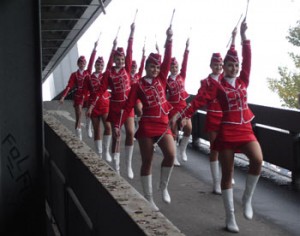Manifesto of Futurist Women (Let’s Conclude), 2008

Dec 13, 2008 – Feb 15, 2009
Neuer Berliner Kunstverein n.b.k. (Germany)
Curated by Marius Babias
Anetta Mona Chişa (Prague) and Lucia Tkáčová (Bratislava) have been working together since 2000, while at the same time pursuing individual careers. In their shared work, they explore gender relations as well as the role of eastern European artists in a western-dominated art world. With videos, installations, textual work, and performances, they refract consumer expectations and trigger processes of reflection about gender questions, the art market, and making art. The exhibition and publication are conceived as an overview of their work. The following publication is their first comprehensive monograph.
…
The preferred medium of the two artists is video, because it can quickly be used in a DIY technique and because, at least in Eastern Europe, it usually was appropriated by male artists. A twofold self-empowerment: the artists take the freedom to transgress the past as well as to choose an artistic medium that they in a sense tear from the male domain. Without explicitly picking up on feminist positions in the historical neo-avant-garde, a few of their works are founded in gender politics, especially their video series Dialectics of Subjection, where the powerful on the stage of world politics and the art world are brutally exposed from the perspective of the woman and artist. In the video Manifesto of Futurist Women (Let’s Conclude), 2008, Chişa and Tkáčová refer to the the “Manifesto of Futurist Women” by Valentine de Saint-Point, 1912.
Self-empowerment in their own Eastern European context is opposed by exclusion in the Western European context. Then as now, background and gender still control artistic success on the art market. The project Private Collection came from this experience; in this project, which has been realized since 2005 in the art centers of Paris, Berlin, London, Vienna, New York, and Zurich, the artists steal objects from galleries around the world, and then exhibit them. The fetish of art, the ultimate sales secret on the art market thus undergoes devaluation to the level of an exchangeable and banal everyday object. The stolen objects, archived like jewels in the exhibition, tell of the mechanisms of inclusion and exclusion of a stylistically lost art world that consists of symbolic charges, speculative claims, and ultimately banal objects of exchange.